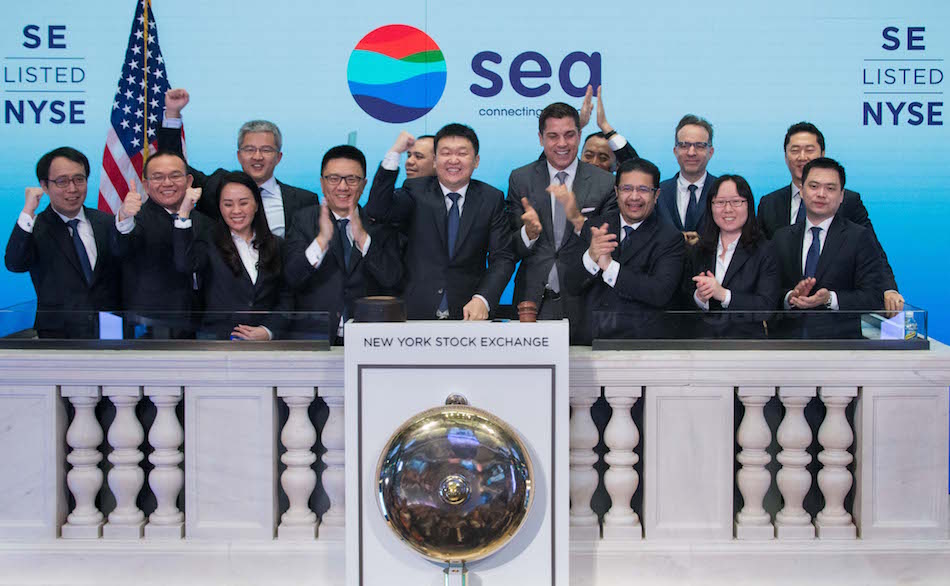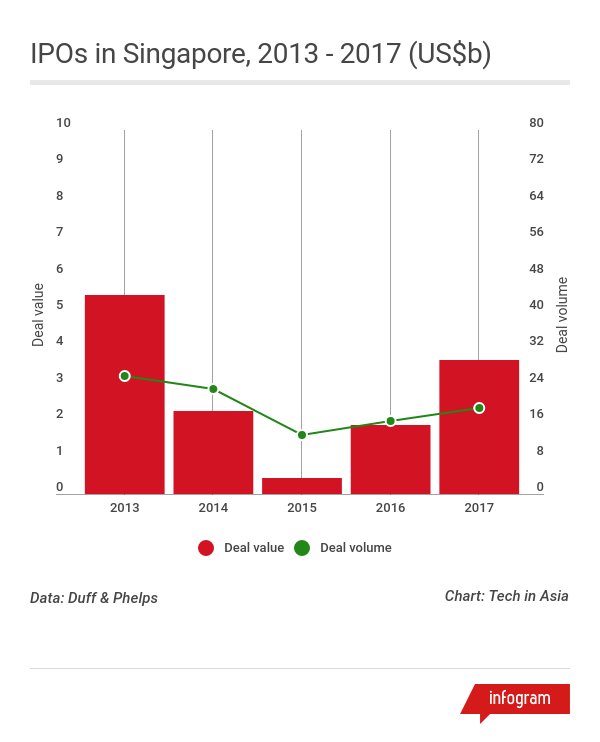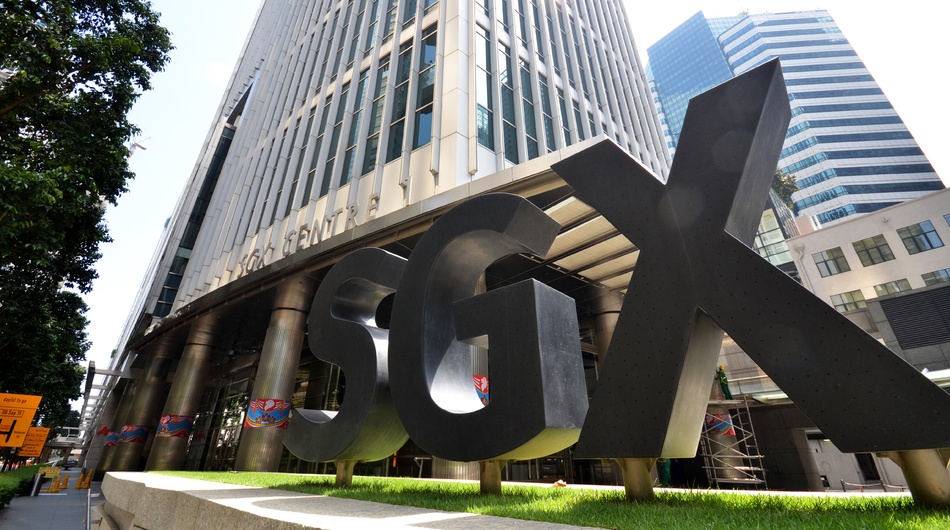
Sea chairman and CEO Forrest Li and president Nick Nash on the podium of the New York Stock Exchange / Photo credit: NYSE
Singapore’s gaming and ecommerce unicorn Sea raised US$884 million on its initial public offering this past October. US-headquartered Razer, another well-loved company with ties to the island nation, had a US$528 million listing in Hong Kong just a month later.
This double whammy wasn’t as impressive as some of Southeast Asia’s IPO blockbusters in 2017. For example, Netlink NBN Trust’s US$1.7 billion listing on SGX topped the IPO charts (Netlink is Singapore’s fiber broadband network owner and telco Singtel’s broadband unit). Cromwell European Real Estate also listed on SGX, raising US$1 billion.
[The Sea and Razer IPOs are] a data point that VCs and founders can point to.
But for the tech startup scene, the Sea and Razer IPOs were still a crackerjack. Not only were the trade debuts long-awaited milestones for both companies, they were also an effective bellwether for Southeast Asian companies with public market aspirations.
Companies in Southeast Asia were waiting to see how the Sea IPO would pan out, so there was subsequently a lot of interest from local and regional tech companies in US listings. Sharon Lau, the Singapore office managing partner of law firm Latham & Watkins, predicts that there will be more high-profile IPOs from the region in late 2018 or early 2019, although she doesn’t share any details.
Rajiv Gupta, also a partner at Latham & Watkins in Singapore, says that local advisors, including banks and lawyers, were asked by IPO candidates to wait and see how the Sea listing would go before going forward with their own. “It was almost seen as a litmus test for the appetite for an Asian tech company IPO in the US,” he says, adding that interest remains strong after the listing.
This holds true even though both companies’ stock prices have dropped since and are trading below their IPO price. Sea’s stock opened today at US$12.58 in NYSE, having started at US$16.26, and Razer’s stock price opened at HKD 3.79 in HKG, having started at HKD 4.58.
“I think it is a recent indicator – a data point that VCs and founders can point to,” says Ferish Patel, partner at law firm Gunderson Dettmer.
The bell tolls for IPOs
Because Sea and Razer listed outside of Singapore, the market they’re more closely associated with, it adds to the debate about the city-state bourse’s attractiveness to tech startups.
This is not so much an indictment of local markets – IPOs in the region are doing quite well, in fact. “2017 was a record year for ASEAN IPOs and technology listings was the second largest category,” says Nam Soon Liew, managing partner at ASEAN Financial Services for Ernst & Young.
According to the Transaction Trail 2017 Report by valuation and financial advisory firm Duff & Phelps, IPO capital value in Singapore doubled last year in comparison to 2016.

But Sea will likely not be the last Southeast Asian tech company to reach out to the global market through a US listing. Lau and Gupta confirm that tech companies and investors are eager for US listings.
While it doesn’t bode well for local exchanges, it’s not hard to see why companies here covet New York City lights. “Investors in the US really understand technology, and they are willing to put in big money,” explains Srividya Gopalakrishnan, managing director at Duff & Phelps Singapore.
This will probably continue to be the case, as long as investors in Singapore have different priorities. “[They] are generally more inclined towards defensive and income-generating stocks,” says Philip Teo, founder and CEO of Traderwave, a Singapore-based startup that helps traders discover, analyze, and monitor stock trading opportunities.
Teo, who has prior public market experience at Singaporean bank OCBC and conducts seminars for retail investors at SGX’s trading academy, thinks that growth-focused companies like tech startups generally don’t appeal to local investors. Such investors are more used to Singapore’s real estate investment trust focus.
Raising money is of course a key motivation for founders going public, right next to increasing their company’s profile and providing exit opportunities for their private investors. But when it comes to raising funds, there’s a lot more private capital to go around these days.
Companies like Grab and Uber, for example, have managed to build up significant war chests without an IPO. As such, startups have one more thing to consider: is it perhaps better to delay a listing and continue raising money privately? “Definitely Razer and Sea’s IPOs offer founders some potential food for thought about whether they should be listing or holding out as long as possible,” Teo explains.
Several companies also have the added option of ICOs these days – the trend peaked this year, as this graph vividly shows.
“ICOs have already surpassed early-stage VC funding despite concerns by regulators and investors alike with money laundering and the inherent volatility,” Liew says. “We expect ICO as a business model to continue to be a source of funding but also evolve with a greater understanding of the risks with evolving regulations.”

SGX Centre, downtown Singapore / Photo credit: tang90246 / 123RF
Singapore needs to do more
SGX has made efforts to become attractive to tech startup listings through a number of initiatives, like engaging with regulator Infocomm Media Development Authority (IMDA) to discover promising companies and allowing for dual-class shares that allow founders to retain control of their company.
But aside from investors coming around to tech startups, SGX might also need to focus on the specific value it can offer local companies.
If the bulk of your customers are in Southeast Asia, perhaps it makes more sense to list here.
Lau believes SGX should take advantage of its streamlined listing process and look more carefully at Southeast Asian and Indian companies, for whom the region is a significant chunk of their business. “A business that’s not going to have a China or North Asia angle is perhaps the kind of company [SGX] should be marketing to,” she says.
As Teo suggests, “a company will usually list on SGX only if their market or their main target audience is actually very near to, or in, Singapore itself.” If the bulk of a company’s customers and market are in Singapore or in Southeast Asia, perhaps it makes more sense to list here instead of a high-profile foreign exchange where it will be just one more company among tens of thousands.
“This is clearly a journey and a continued focus on shortening the time to market and making it more cost- and process-effective for listing will help,” Liew observes. “We see a strong pipeline of potential technology listings and 2018 should prove to be another strong year, given the continuing strong economic growth and positive equity markets.”
Gopalakrishnan has confidence in Singapore’s potential as a market for tech listings. “If somebody asked last year, I don’t think anyone would have said that Hong Kong would be the next market for [such companies],” she says. “But Hong Kong has managed to show there are actually investors interested in putting money in tech. I have a very positive feeling that Singapore will do the same but it may take a little more time because Singapore is fairly conservative. If Hong Kong can do it, then Singapore can as well.”
This post Sea, Razer IPOs will get more startups to go public, but when will SGX attract them? appeared first on Tech in Asia.
from Tech in Asia https://www.techinasia.com/tech-ipo-boom-sea-razer
via IFTTT
No comments:
Post a Comment